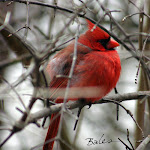•



Bob Thomas from Pigeon Forge sent me these photos of a Cooper's hawk (note the white at the tip of a barred tail) bathing in his fountain. It's happened before but this time he also noticed a second Coop in a nearby tree watching the splish-splash.
Because of the time of the year, I first thought it was a parent Cooper's teaching its young how to bathe. But on my computer, I was able to enlarge the photos and look closer at their eyes, both have blue-gray eyes, the sign of a young bird. So the pair were fledglings, probably siblings, one watching out for the other.
As Cooper's hawks age their eyes change color: bluish-gray in fledglings, to yellow in young adults and finally to the red of older adults. (A red-tailed and red-shouldered hawk's eyes go from yellow to hazel to dark brown as they age.)
Of course, you rarely are so close you get to see a hawk's eye color. That's why Bob is so lucky.
Thanks, Bob.
 | |
| A second Cooper's watched from a nearby tree |
•



































































No comments:
Post a Comment